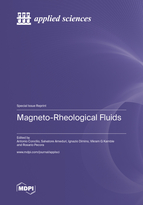Magneto-Rheological Fluids
A special issue of Applied Sciences (ISSN 2076-3417). This special issue belongs to the section "Fluid Science and Technology".
Deadline for manuscript submissions: closed (20 September 2022) | Viewed by 22013
Special Issue Editors
Interests: adaptive structures; smart structures; morphing; structural health monitoring; integrated vehicle health monitoring; vibroacoustic control
Special Issues, Collections and Topics in MDPI journals
Interests: morphing wings; smart materials; noise and vibration control
Special Issues, Collections and Topics in MDPI journals
Interests: morphing technology; smart structures; active control; topology optimization
Special Issues, Collections and Topics in MDPI journals
2. Institut für Werkstoffwissenschaft, Technische Universität, 01062 Dresden, Germany
Interests: MR fluids; MR elastomers; smart materials; soft actuation; piezoresistive materials
Interests: smart structures; smart aircraft technologies; morphing structures; structural dynamics; vibration control; dynamic aeroelasticity; non-linear dynamics; mechanics and experimental dynamics
Special Issues, Collections and Topics in MDPI journals
Special Issue Information
Dear Colleagues,
Magneto-rheological fluids offer unique opportunities for realizing adaptive structural systems capable of modulating their response by properly modifying their stiffness and their damping. Since the related transformations occur at a rate well beyond the classical kHz magnitude, a sort of standard reference for structural systems bandwidth, they can suit the realization of adaptive control systems well for optimizing, for instance, impact energy diffusion, as for shock absorbers, landing gears, adaptive bumpers, and so on, or dynamic response by stiffness adjustment, useful for noise control, maneuver optimization, direction control, and so on. For their nature, the range of applicability spreads all over transport vehicles, interesting automotive, including motorcycles, aeronautic, naval, heavy transport, and even in the biomedical field, with more and more efficient prosthetic applications. The evolution of MRF devices may be easily tracked on scientific literature ranging all along the last thirty years and more. The ambition of this Special Issue is instead to concentrate on the applications of this technology, pointing at its potentiality, and its limitations, trying to provide a reliable picture of the state of the art in terms of reliability and marketability of MRF-based devices. This Special Issue shall then be focused on these aspects, transversal to the different segment of sea, ground, air transportation, and medical:
- Bumpers
- Shock absorbers
- Landing gears
- Adaptive stiffness devices
- Vibration absorbers
- Seismic alleviation
- Control systems
- MRF system integration
- Prosthetics
- TRL
Dr. Antonio Concilio
Dr. Salvatore Ameduri
Dr. Ignazio Dimino
Dr. Vikram G Kamble
Dr. Rosario Pecora
Guest Editors
Manuscript Submission Information
Manuscripts should be submitted online at www.mdpi.com by registering and logging in to this website. Once you are registered, click here to go to the submission form. Manuscripts can be submitted until the deadline. All submissions that pass pre-check are peer-reviewed. Accepted papers will be published continuously in the journal (as soon as accepted) and will be listed together on the special issue website. Research articles, review articles as well as short communications are invited. For planned papers, a title and short abstract (about 100 words) can be sent to the Editorial Office for announcement on this website.
Submitted manuscripts should not have been published previously, nor be under consideration for publication elsewhere (except conference proceedings papers). All manuscripts are thoroughly refereed through a single-blind peer-review process. A guide for authors and other relevant information for submission of manuscripts is available on the Instructions for Authors page. Applied Sciences is an international peer-reviewed open access semimonthly journal published by MDPI.
Please visit the Instructions for Authors page before submitting a manuscript. The Article Processing Charge (APC) for publication in this open access journal is 2400 CHF (Swiss Francs). Submitted papers should be well formatted and use good English. Authors may use MDPI's English editing service prior to publication or during author revisions.
Keywords
- magneto-rheological fluids
- landing gears
- shock absorbers
- bumpers
- adaptive stiffness
- vibration absorbers
- noise and vibration attenuation
- seismic alleviation
- prosthetics
- control systems
- MRF integration
- TRL










